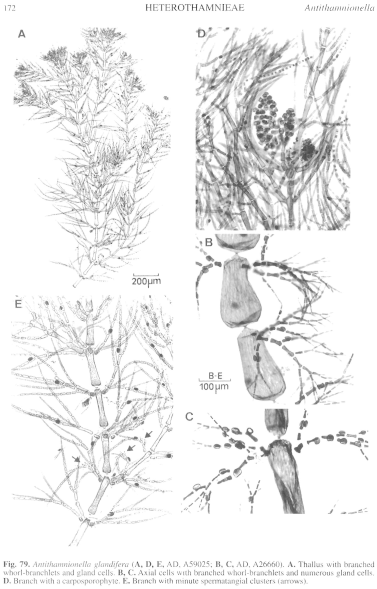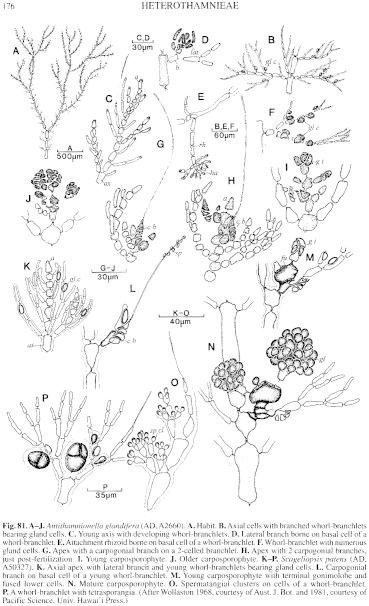|
|
|
|
|
|||||||||||
|
Electronic Flora of South Australia Species Fact Sheet
Phylum Rhodophyta – Order Ceramiales – Family Ceramiaceae – Tribe Heterothamnieae
Selected citations: Athanasiadis 1996: 114, fig. 51.
Thallus (Figs 79A, 81A) medium red-brown, largely erect, 1–2.5 cm high, with lateral branches from every third axial cell above but often up to 6 cells apart below, arising on basal cells of whorl-branchlets (Fig. 81D). Axial cells with 1–3 (usually 2) whorl-branchlets (Figs 79E, 81B). Attachment by several-celled rhizoids from the basal cells of whorl-branchlets in the lower thallus, with terminal branched haptera (Fig. 81E); probably epiphytic. Structure. Apical cells 5–6 µm in diameter and L/D 1.5–2, enlarging gradually (Fig. 81C) to axial cells 30–40 µm in diameter and L/D 2–4 in the mid thallus, then to 70–180 µm in diameter and L/D 1–3 in the lower thallus, with the lower end broader than the upper. Whorl-branchlets usually separated, unbranched near the apices but with (2–) 3–5 alternate branches below (Figs 79B, C, 81B), 200–350 µm and 10–14 cells long; basal rachis cells branched or not, as long as next cells, 12–20 µm in diameter and L/D 1.5–2 (–2.5), tapering gradually to terminal cells 5–7 µm in diameter and L/D 2–4, with rounded ends; gland cells prolific on lower whorl-branchlets (Figs 79B, C, 81F), sparser above, on cells of the rachis or its branches, cut off from subterminal cells and touching only the bearing cell, ovoid, 6–8 µm in diameter. Cells uninucleate; rhodoplasts discoid to elongate in small cells, ribbon like in larger axial cells.
Reproduction: Gametophytes probably dioecious. Carpogonial branches (Fig. 81G, H) occur on 2-celled whorl-branchlets close to branch apices, singly or on 2 successive axial cells, with the terminal cell appearing as a small sterile cell on the supporting cell. Post-fertilization a terminal gonimolobe develops (Fig. 81I) followed by 2 (or more) lateral, rounded to elongate, gonimolobes (Figs 79D, 81J); no involucral branches occur. Spermatangia on small adaxial clusters on lower whorl-branchlet cells (Fig. 79E).
Tetrasporangia unknown.
Type from 5–8 km off Outer Harbor, S. Aust., 16 m deep (Loan, 9.viii.1963); holotype in AD, A26660.
Selected specimens: Port Stanvac, S. Aust., on jetty pylons, 3–12 m deep (Clarke, 23.ii.1977; AD, A59025). Beauty Point, River Tamar, Tas., upper sublittoral on an old barge (Wollaston & Mitchell, 5.iii.1964; AD, A28019).
Distribution: Known from the type, Port Stanvac, S. Aust., and Beauty Point, Tamar Estuary, Tasmania.
References:
ATHANASIADIS, A. (1996). Morphology and classification of the Ceramioideae (Rhodophyta) based on phylogenetic principles. Opera Botanica No. 128, pp. 1–216.
WOLLASTON, E.M. (1968).Morphology and taxonomy of southern Australian genera of Crouanieae Schmitz (Ceramiaceae, Rhodophyta). Aust. J. Bot. 16, 217–417.
The Marine Benthic Flora of Southern Australia Part IIIC complete list of references.
Publication:
Womersley, H.B.S. (24 December, 1998)
The Marine Benthic Flora of Southern Australia
Rhodophyta. Part IIIC. Ceramiales – Ceramiaceae, Dasyaceae
©State Herbarium of South Australia, Government of South Australia
Illustrations in Womersley Part IIIA, 1998: FIGS 79, 81 A–J.

Figure 79 enlarge
Fig. 79. Antithamnionella glanchfera (A, D, E, AD, A59025; B, C, AD, A26660). A. Thallus with branched whorl-branchlets and gland cells. B, C. Axial cells with branched whorl-branchlets and numerous gland cells. D. Branch with a carposporophyte. E. Branch with minute spermatangial clusters (arrows).

Figure 81 enlarge
Fig. 81. A–J. Antithamnionella glandifrra (AD, A2660). A. Habit. B. Axial cells with branched whorl-branchlets bearing gland cells. C. Young axis with developing whorl-branchlets. D. Lateral branch borne on basal cell of a whorl-branchlet. E. Attachment rhizoid borne on basal cell of a whorl-branchlet. F. Whorl-branchlet with numerous gland cells. G. Apex with a carpogonial branch on a 2-celled branchlet. H. Apex with 2 carpogonial branches, just post-fertilization. L Young carposporophyte. J. Older carposporophyte. K–P. Scageliopsis patens (AD, A50327). K. Axial apex with lateral branch and young whorl-branchlets bearing gland cells. L. Carpogonial branch on basal cell of a young whorl-branchlet. M. Young carposporophyte with terminal gonimolobe and fused lower cells. N. Mature carposporophyte. O. Spermatangial clusters on cells of a whorl-branchlet. P. A whorl-branchlet with tetrasporangia. (After Wollaston 1968, courtesy of Aust. J. Bot. and 1981, courtesy of Pacific Science, Univ. Hawai'i Press.)

|
Email Contact: State Herbarium of South Australia |

|